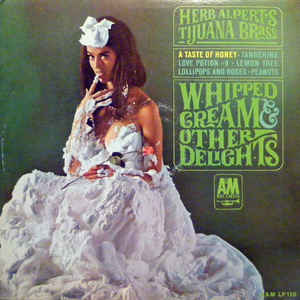Until about four decades ago, there was a radio format called Middle Of The Road. The stations were targeted at adults 35-64, with hosts who were allowed to inject some personality between songs, newscasts, traffic reports, etc. The format included pop songs that weren’t quite rock and roll (The Beatles’ “Michelle,” but not “Revolution”), some show tunes, and a lot of ballads. It eventually morphed into what is now called Adult Contemporary.
At its height in the 1960s and 1970s, MOR station playlists included artists like Herb Alpert & The Tijuana Brass and Helen Reddy. There were many others, of course, but I mention those two because I’ve just watched movies about them.
“I Am Woman” is a docudrama about Reddy, who is still most famous for her feminist anthem, which became a number one hit in 1972 and has been resurrected several times since — including at the Women’s Marches across the US the day after Trump was inaugurated.
The story begins when Reddy arrived in New York from Australia in 1963 with a young daughter in tow and all of $230 in the bank. She hoped to have a career as a singer, but it was very slow going at the start. Not only did she have trouble finding gigs, but when she did get work in some dive bar, she was paid less than the male band members who backed her up.
Fortunately, Reddy connected with Lillian Roxon, an ex-pat Australian who was already one of the most important music critics in the US, among the first to write regularly about rock bands and performers. Roxon wrote the world’s first rock encyclopedia, was one of the early promoters of the feminist movement, and inspired Reddy to write “I Am Woman.” The song led to a major dispute with her record label, which refused to release it as a single. But Reddy’s husband/manager, Jeff Wald, convinced the execs to put it on the album, then engineered popular demand by targeting the female audience the label was ignoring. The rest is history.
Along the way, Reddy racked up more hits, like “You And Me Against The World,” “Delta Dawn,” “Leave Me Alone,” and “Angie Baby,” all of which kept her on both MOR and Top 40 radio for at least five years. She toured the world, became a Las Vegas headliner, guested on lots of TV variety shows, and even hosted one of her own. Towards the end, though, Wald’s habit of snorting coke, spending more time managing his other acts (including Deep Purple and Tiny Tim), and losing all of her money in some very bad business decisions led to Reddy divorcing him just as her popularity was fading out.
In “I Am Woman,” Reddy is played beautifully by Tilda Cobham-Hervey as the character ages from 22 to 48 (the singing is done by Chelsea Cullen). She makes the viewer empathize with the struggles of a newcomer who became a star and cultural juggernaut. Evan Peters plays Wald as a slick-but-sleazy character who loses focus on the woman who helped make him rich and powerful. But it’s Danielle Macdonald who steals every scene she’s in as Roxon, a woman who was a force to be reckoned with and earned the moniker, “The Mother Of Rock.”
I give “I Am Woman” a 7.5 out of 10. It’s streaming on Netflix.
The other movie about an MOR artist is “Herb Alpert Is…,” a documentary about the one-time leader of the Tijuana Brass who later co-founded A&M, the most successful independent music label in history.
The doc includes lots of footage of Alpert and his band finding success with their unique sound in the 1960s, racking up instrumental hits like “Tijuana Taxi,” “A Taste Of Honey,” and “The Lonely Bull.” In all, he had five number one albums, won nine Grammys, sold 72 million records, and packed stadiums worldwide. He’s also the only person to hit number one both as a vocalist (Burt Bacharach’s “This Guy’s In Love With You” in 1968) and as a musician (“Rise” in 1979).
Unfortunately, the movie doesn’t spend enough time showing us how Alpert and Jerry Moss built A&M records. Though we hear briefly from Sting praising Alpert, I would have liked to learn more about how he and The Police were signed to the label. The same goes for Peter Frampton — whose 1976 live album became one of the biggest sellers of all time — as well as Styx, Supertramp, Bryan Adams, Sheryl Crow, and dozens of others.
There is a nice sequence in which Richard Carpenter explains how Alpert guided him and his sister Karen to success (again, especially on MOR radio), and music business luminaries like Quincy Jones, Terry Lewis, and Lou Adler share their stories of working with Alpert. But I wish there had been more emphasis on the rockers whose careers he helped (and how he did it). Instead, we get lots of footage of Alpert creating art (paintings and sculptures), his philanthropy, and his longtime marriage to Lani Hall, the original lead singer of Sérgio Mendes’ group, Brasil ’66.
Like his music — which was good to hear again — it’s all very nice. And very middle of the road.
The one sequence in the movie that has any edge regards the Tijuana Brass’ most famous album, “Whipped Cream And Other Delights,” the cover of which became more famous than the music it contained, as several male interviewees attest. Suffice to say that more than a few boys immediately entered puberty thanks to that cover art.
I give the documentary “Herb Alpert Is…” a 7 out of 10. It’s available via video-on-demand.
What’s fascinating to me is that both Reddy and Alpert were once so popular that almost every record they released got massive airplay. Yet today, years after the MOR format went away (like Easy Listening), I doubt there’s a terrestrial radio station that even has their music in its library, let alone on its playlist.


